What? A “personal luxury” car? Are we going to glorify “neoclassic” cars next? Have we really reached the bottom of the barrel with Pontiac cars already for Pontiac Pthursday?
Hold on a minute. The 1969 Grand Prix was an early vision of what an American gran touring sport/luxury coupe might look like before the Big Three went overboard with landau roofs and Corinthian leather. Many consider this Grand Prix to be the very first true “personal luxury” car, and initially the concept didn’t involve crap like wire wheel covers or opera windows. In fact, in barely over 100 examples it involved a whopping 390 horsepower V8 hooked up to a four-speed manual transmission. Now are you willing to give this thing a chance?
You’re Not Running Any Grand Prix In That Aircraft Carrier
One of the most impossible tasks in the automotive world is to totally change the image of a car company from something stodgy and workmanlike to sporty and exciting. There’s a long list of “not your father’s Oldsmobile” and “the Caddy that zigs” failures.
We might know John DeLorean for his well-publicized failures and transgressions, but almost certainly one of the greatest image-turnaround successes in automotive history was his total transformation of Pontiac.
Pontiac already had the very beginnings of this change with the introduction of “wide track” in 1959. This all began when then-General Manager Bunkie Knudsen was observing the clay mockups of upcoming models according to a quote Knudsen shared for a 1994 interview in High Performance Pontiac magazine.:
“At that time, although the body styling was very appealing with the normal tread, the new Pontiac looked like a football player in ballet shoes,” Knudsen recalled. “(Chief Engineer) Pete (Estes) and I moved the wheels out as a styling measure and it looked fantastic. We checked it out and found that the cost to make the change was minimal, so we went ahead and it was well worth it.”
Working closely with Knudsen was a new assistant chief engineer who would later become famous (or infamous) for building a stainless steel sports car. Delorean took the ball and ran with it, being instrumental in the creation of arguably the first official muscle car, the Pontiac GTO. However, Delorean also developed a vision for something on a higher level: a luxurious yet somewhat sporting grand touring coupe. This would be a car akin to the European Facel-Vega or the mid-fifties Chrysler 300 “letter series”; a sort of “banker’s hot rod” with high performance hidden beneath a subdued, upscale veneer. Enter the 1962 Pontiac Grand Prix like this one for sale by RM Sotheby’s.

Based on that year’s Catalina, the first Grand Prix featured a different grille and headlights, plus less chrome trim, but the big changes were below the surface.
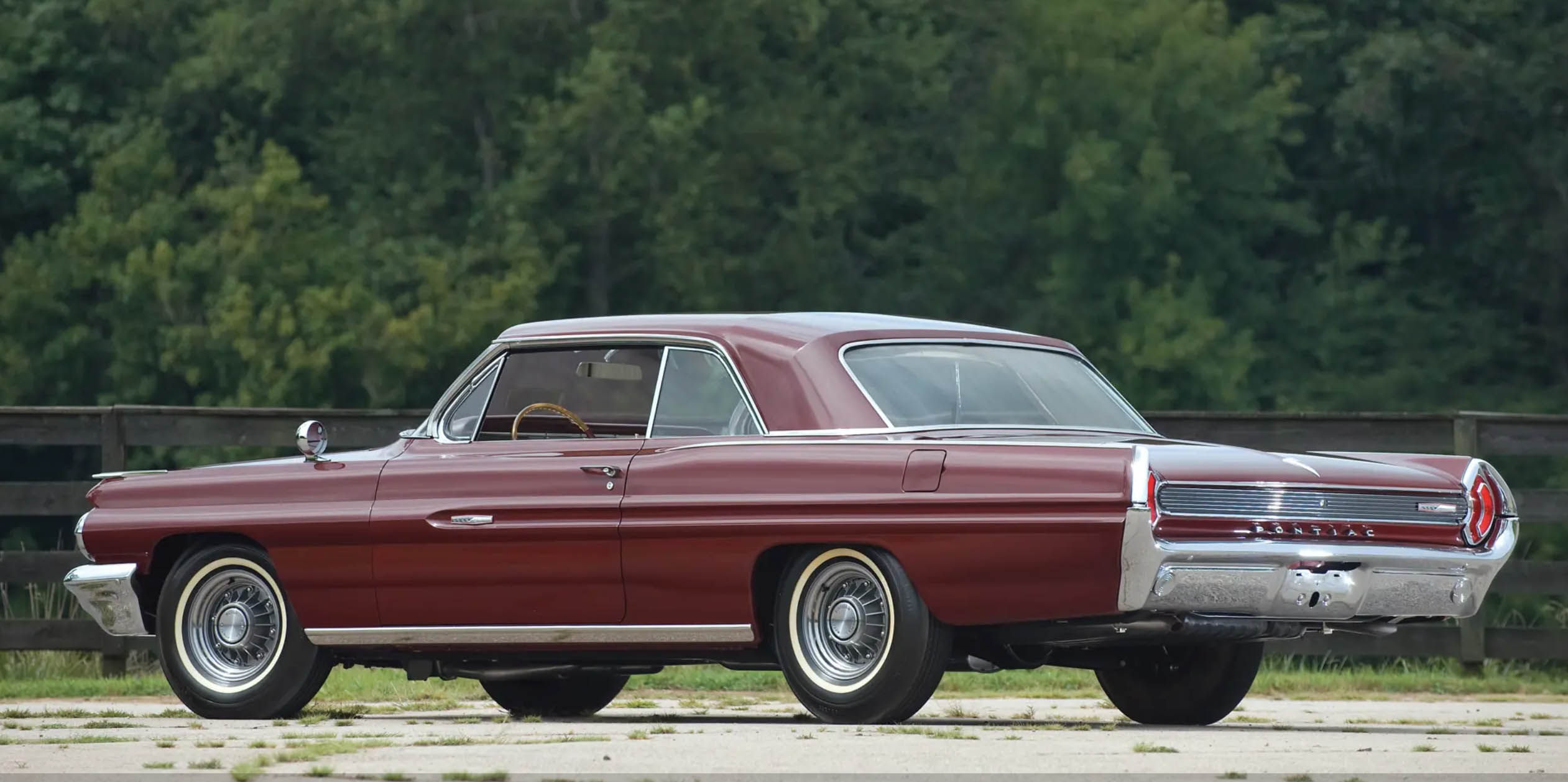
Bucket seats flanked a center console with a floor shifter and tachometer in probably the worst place imaginable for such an instrument. The rear bench was split by a fold-down armrest and speaker grille to give a sort of “bucket seat” look. The whole idea was to create a lower priced alternative to something like a Ford Thunderbird as and early version of what would eventually be called a “personal luxury car”.
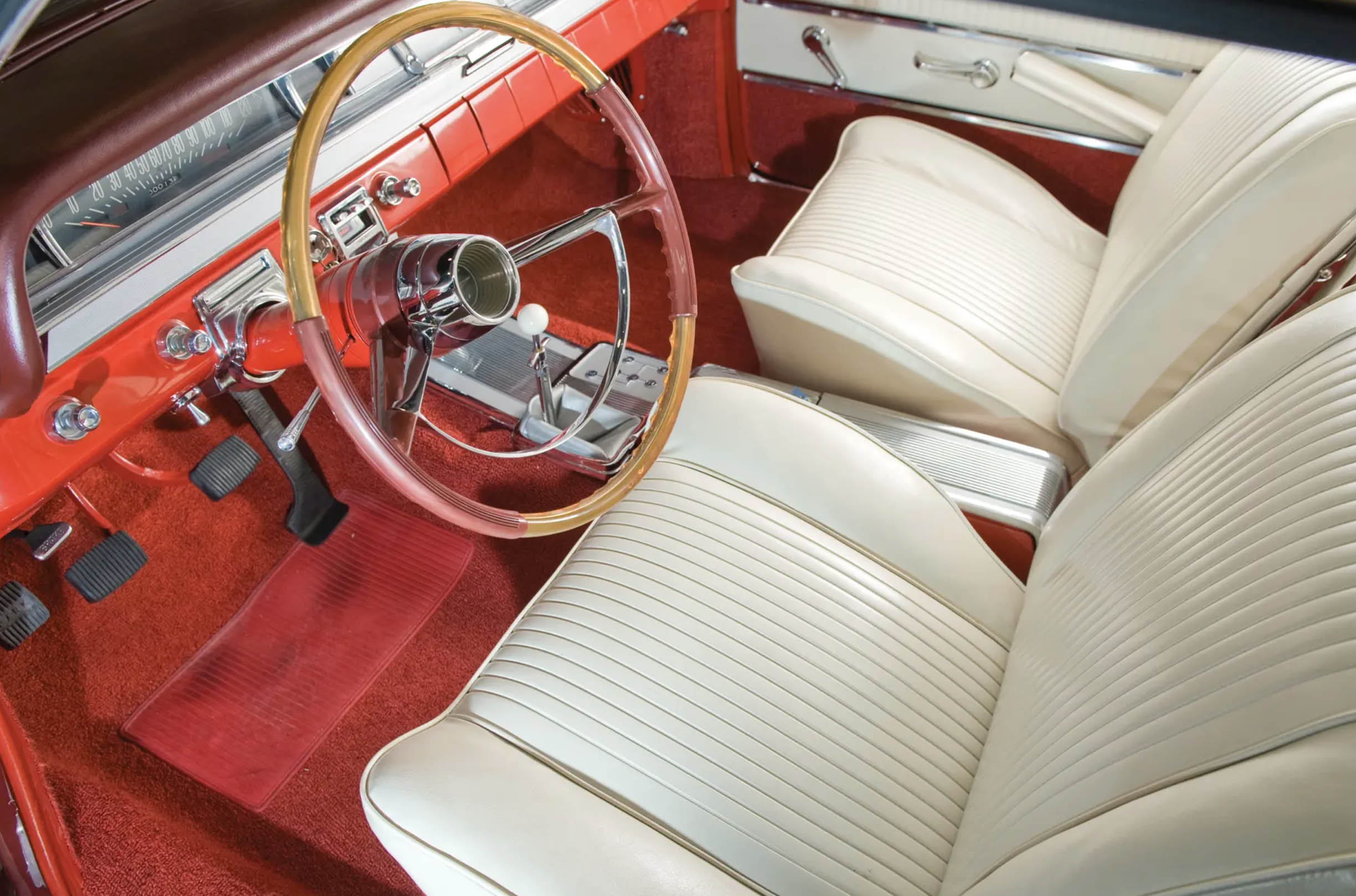
Under the hood, a 303 horsepower “Trophy” version of the 389 V8 sat with a four barrel carburetor and dual exhaust. A standard three-speed manual transmission could be replaced with an optional console-mounted four-speed manual or Hydra-Matic automatic. As in typical sixties fashion that was just the beginning; you could add “tri power” or three two-barrel carburetors for up to 348 hp. The ultimate was the 421 cu in Super Duty with two four-barrel carburetors rated at 405 hp which would truly turn this luxurious and tasteful looking coupe into something fierce.
The Grand Prix could even be specified with Pontiac’s famous “eight lug” wheels that bolted directly to finned brake drums. Ostensibly the fins around the center cap would dissipate heat since they were part of the same casting. Boy, that would be a paint to change a tire by the Cross Bronx Expressway in the rain; I promise at least one of those bolts would be frozen.
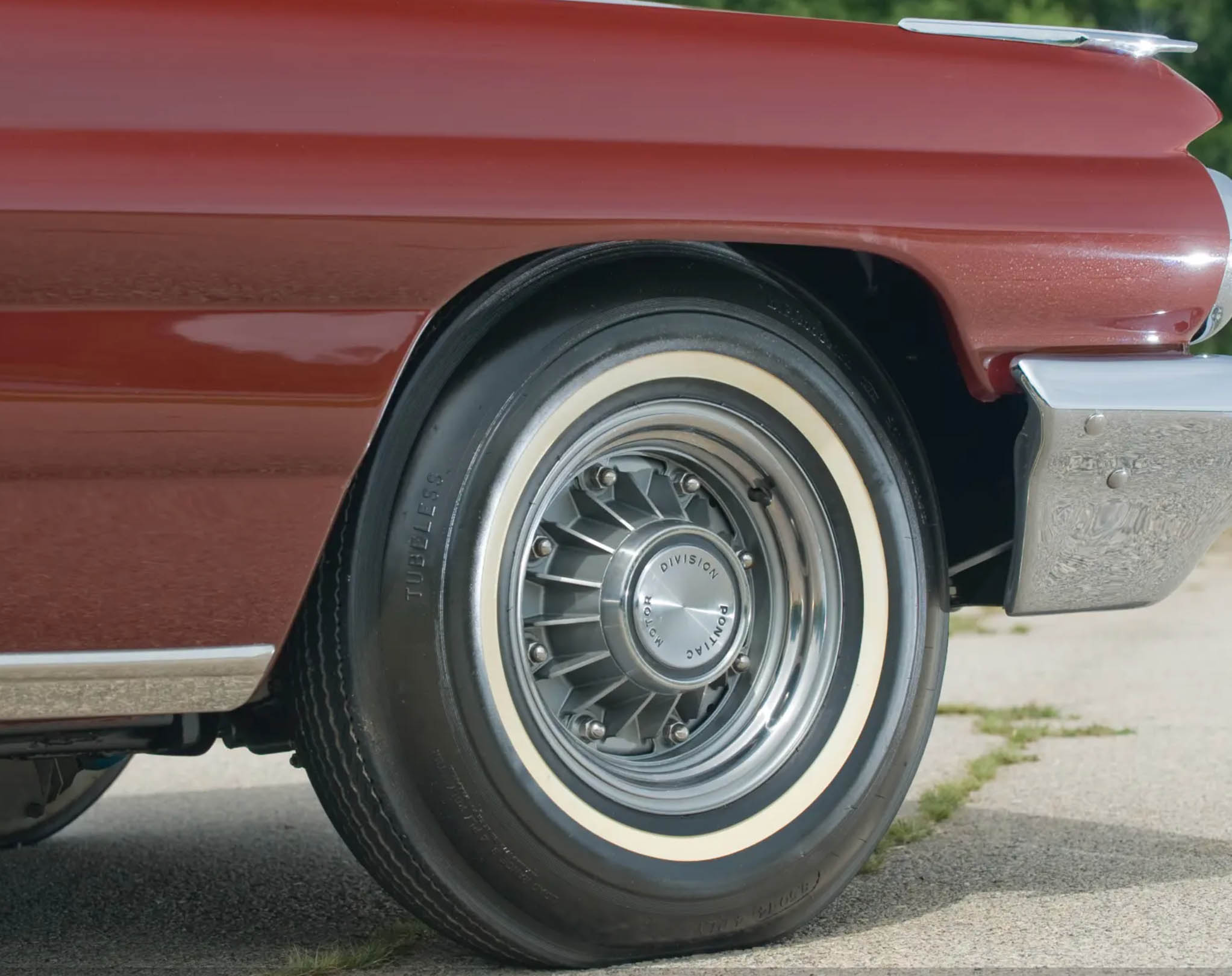
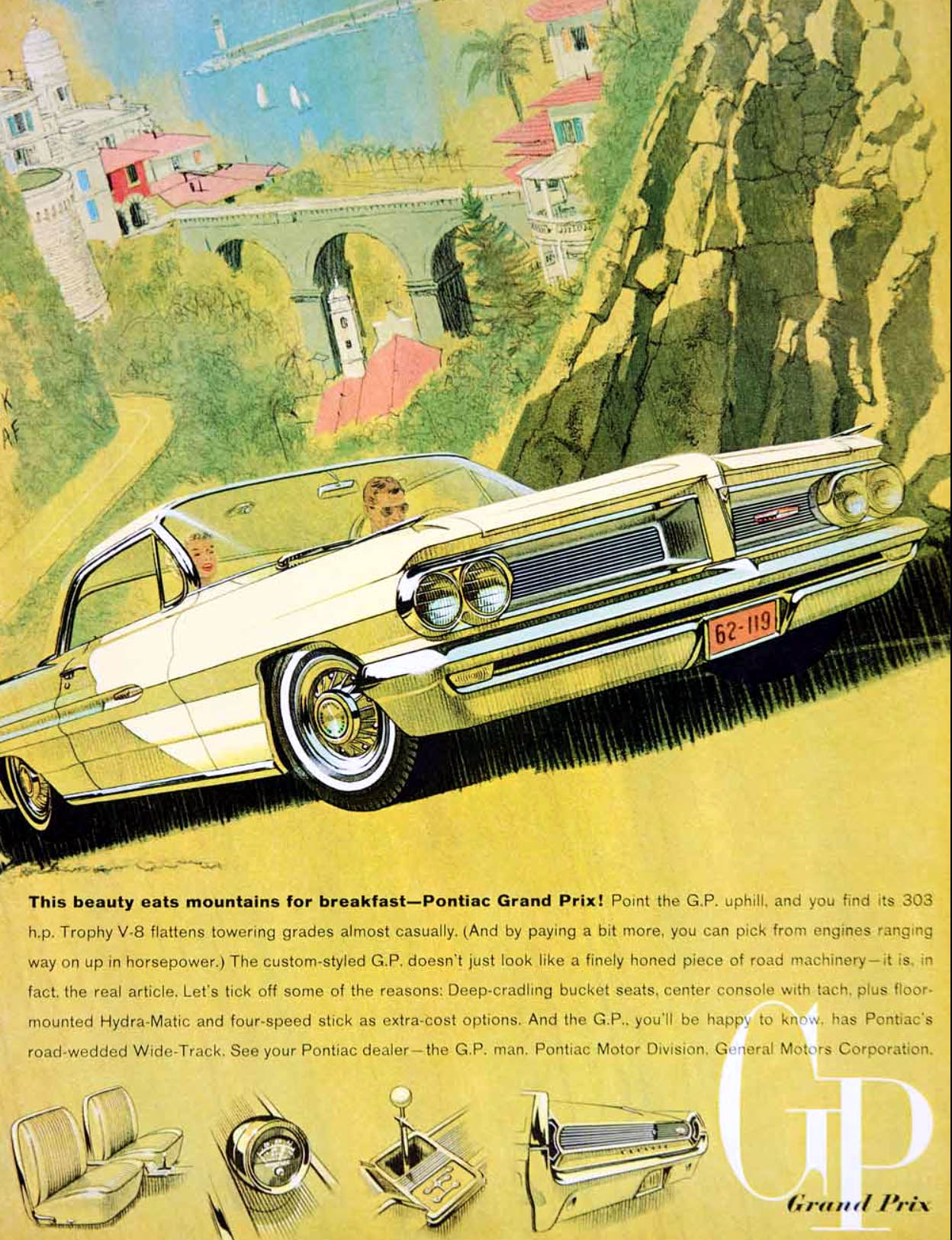
For 1965, the Grand Prix grew slightly and gained a more rounded, heavier look that even included rear fender skirts which gave the car a bit too much of a luxo-barge appearance. Regardless, you could still get an engine that could keep up the “sport” end of the sport/luxury bargain. Top power choice as a 421 cubic inch HO Tri-Power rated 376 hp and still available with a manual transmission.
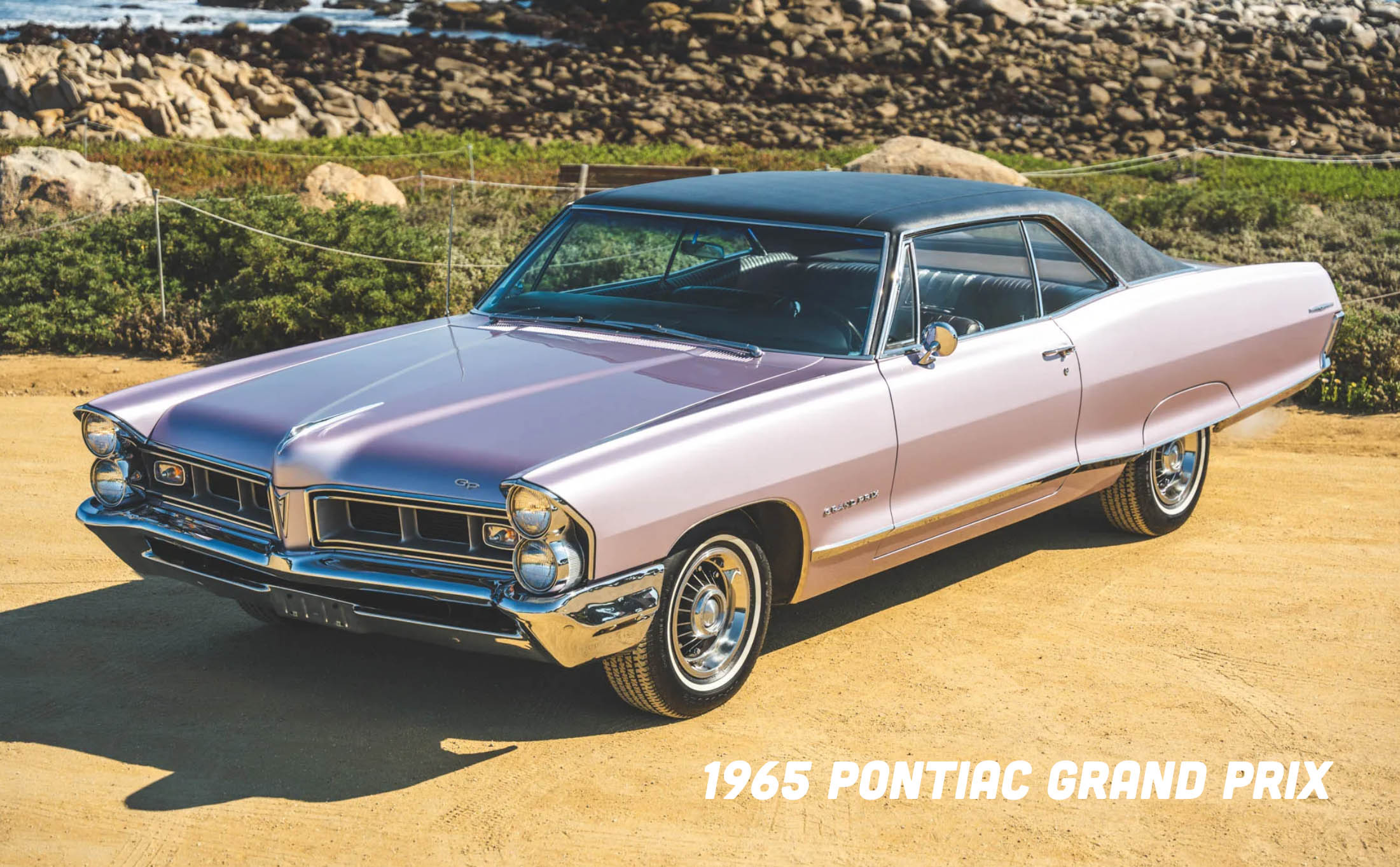
Covered headlights on the later ’67 and ’68 models looked sinister, and power was up to 390 horsepower even with new emissions controls and a change to just one four barrel carburetor. Sales dropped from the 57,881 units sold in 1965 down to a mere 31,178 in 1968.
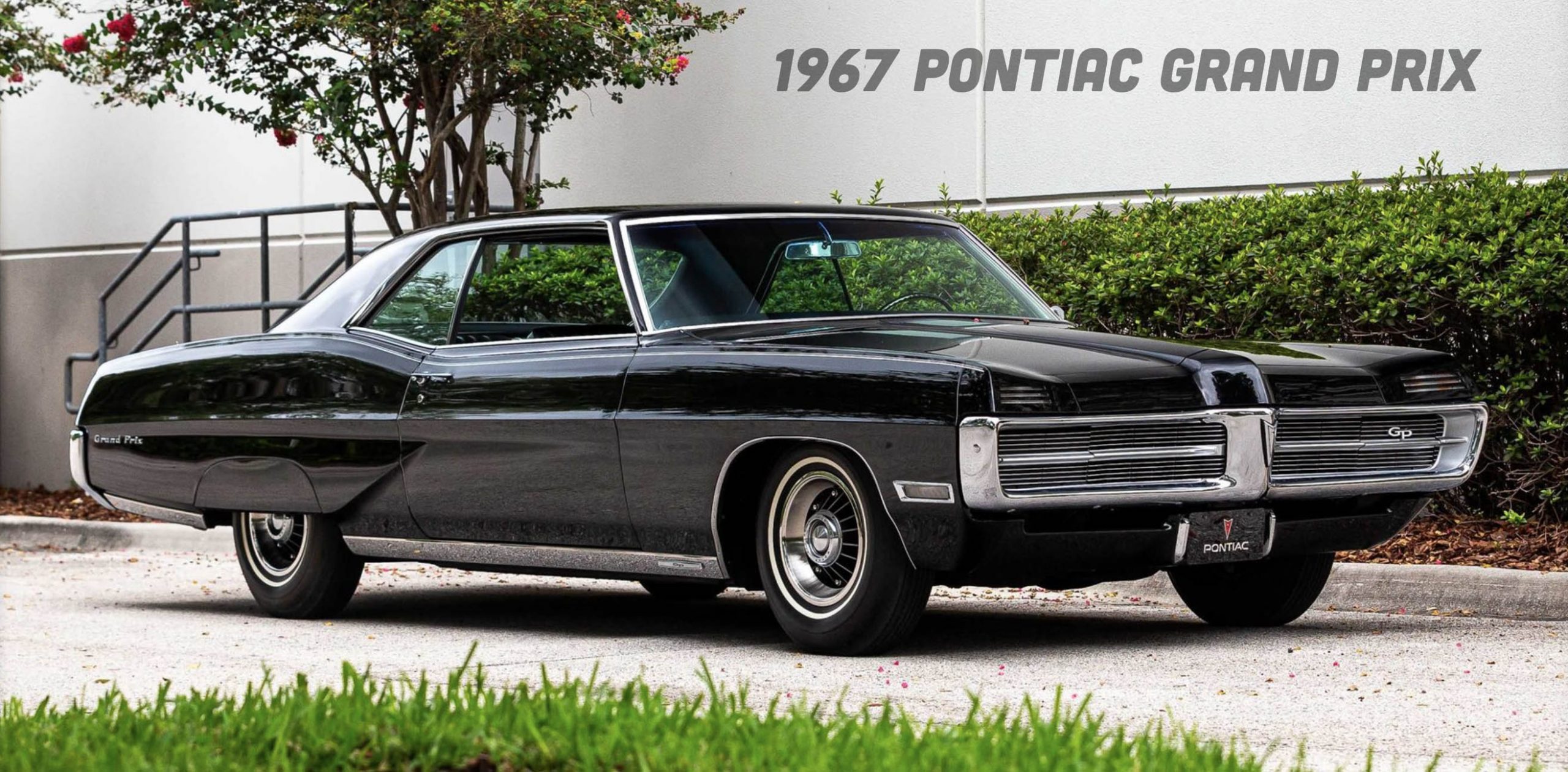
The Grand Prix never strayed too far into overt muscle territory. That was a job given to the ultra-rare Catalina 2+2, a car marketed directly as a big brother to the vaunted GTO (and one I’ll delve into later since I need to save Pontiacs if I ever stand a chance of keeping this every-Thursday thing up).
These massive “sumo class” Grand Prix were indeed cool and offered a fair dose of power, but they didn’t really differ that much from other full-sized Pontiac coupes and truthfully were too big to be convincing as the “personal luxury” grand turismo cars that John Delorean really had in mind. He would change that for the Grand Prix in 1969, and it would change the game entirely for the next few decades.
Like A GTO With An MBA
Now, by moving the Grand Prix down to a platform the same size as the GTO could have caused some issues with people seeing double; an issue that plagued GM in the years to come. Pontiac’s solution was to create a stretched mid-sized A platform to be dubbed the G platform stretched by six inches. Sharing mechanicals with the LeMans, Tempest and GTO allowed for a development time of only 18 months, or half the time typically needed. The question was, with so much sharing would the new Grand Prix be lost among lesser Pontiac brethren?
The answer was no; the look was like no other Pontiac. The new Grand Prix sported the longest hood ever put onto a Pontiac for classical proportions meant to evoke classic American marques like Duesenberg, as shown here in this ad by Orlando Classic Cars:
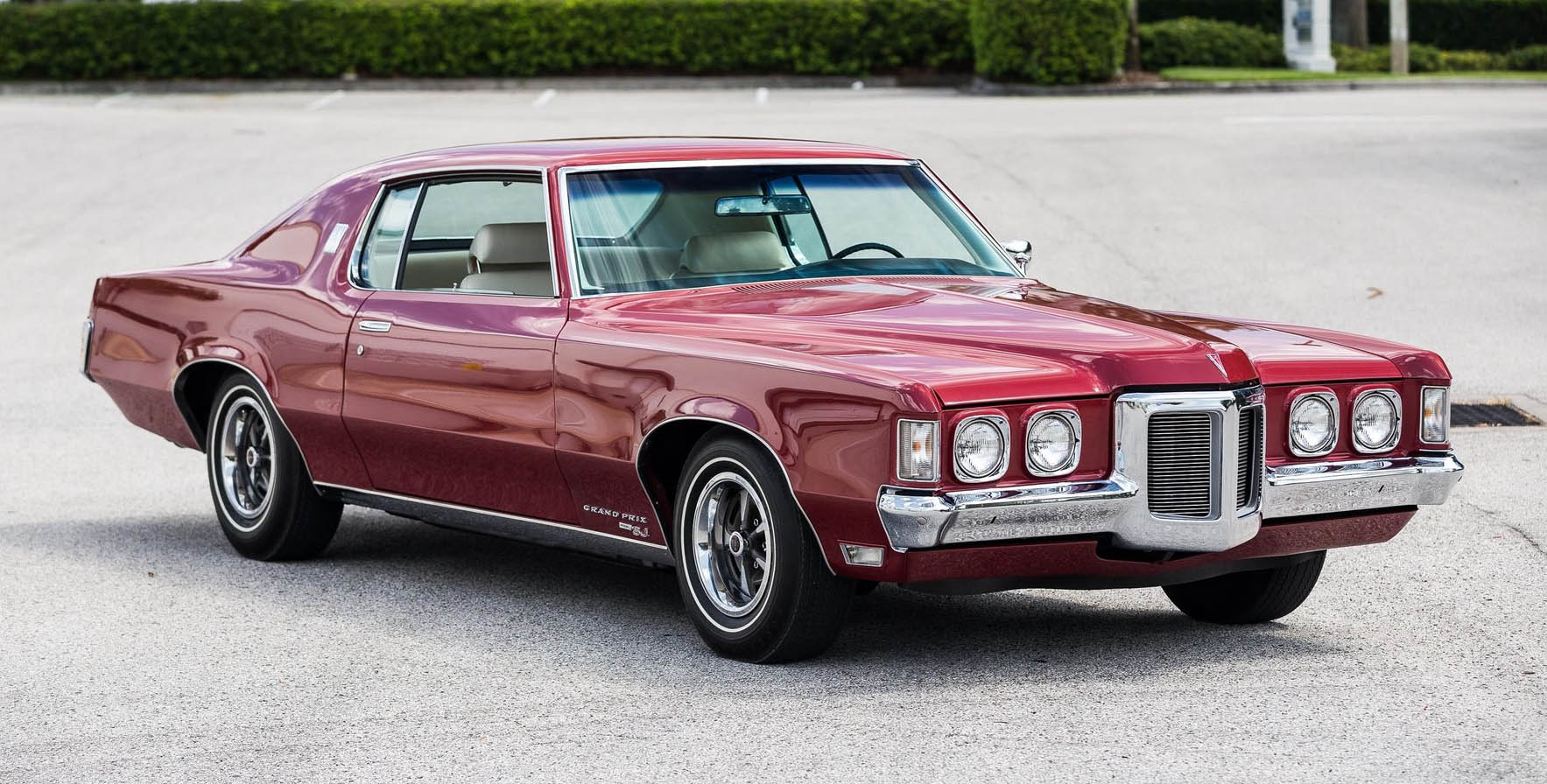
Combined with the large pointed “beak” grille you’d think this thing would appear cartoonish but it didn’t; GM styling in the late sixties really could do no wrong. With subtle semi-fastback design of the rear to counter the aggressive front, you had a remarkably attractive car. Flip-out door handles were a Grand Prix exclusive seemingly copied by Tesla years later, and this Pontiac was the first to feature the windshield-mounted GM antenna (that initially didn’t really work that well). DeLorean even used the Duesenberg designations of “J” and “SJ” to denote the different levels of this new coupe.
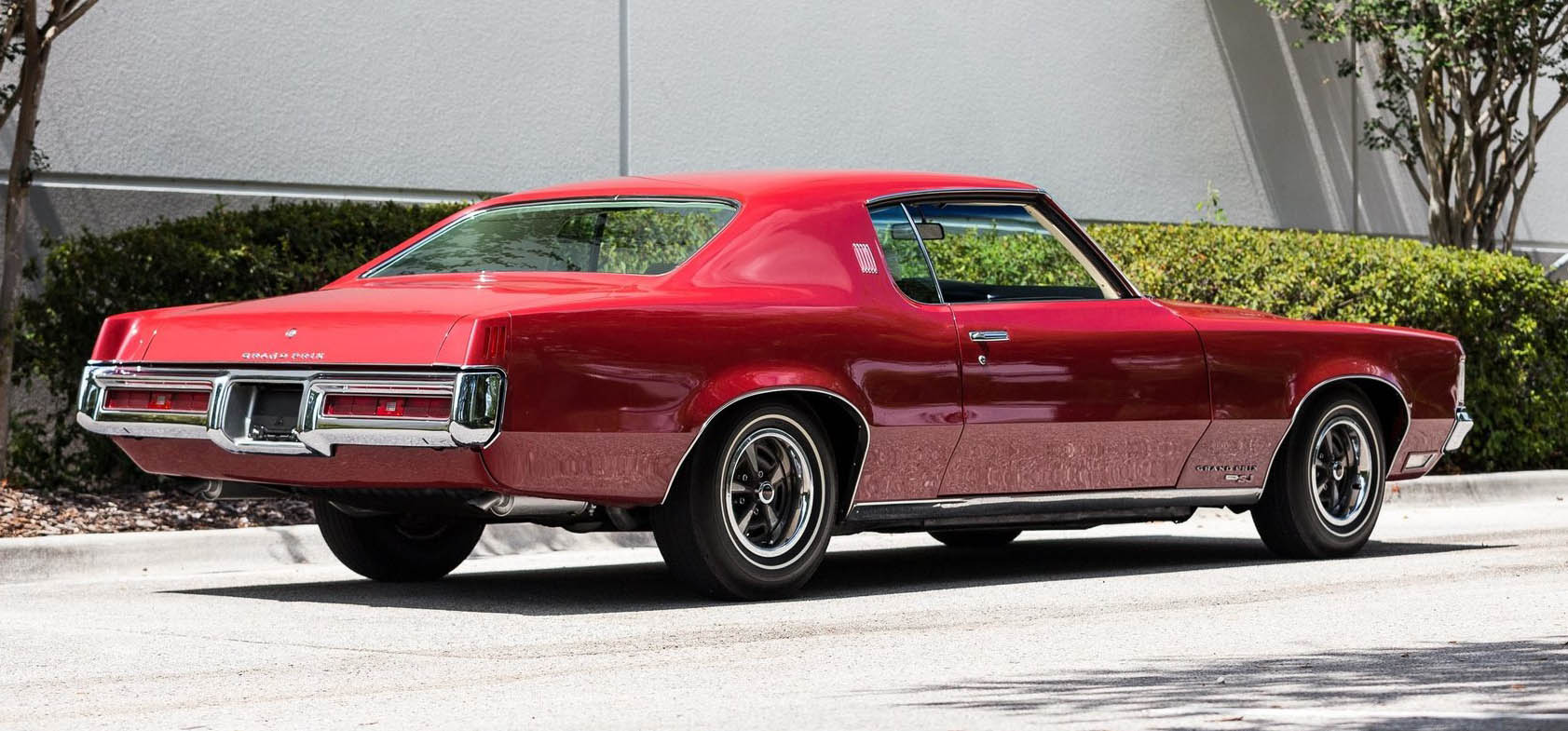
A review in period by Car Life magazine summed it up well:
The crew at Pontiac must have been thinking: “What are we going to sell to the young guy who bought the GTO in ‘64? He’s older now, making more money, a little settled down now that he’s married, and on his way in a good career. Things are good, and he’s ready to be spoiled. But he doesn’t want to sacrifice the thrill of driving. What is being built that combines GTO-style performance with luxury?”
Enter the grandest of the Grands Prix, the luxury enthusiast’s car.
Inside, it was just as good as the exterior. The bucket seats sat behind a driver-focused dashboard with round gauges and secondary controls angled towards the steering wheel. That’s right, front seat passenger: you leave the radio alone! Console and floor shifter were standard; there’s no tach in the main cluster of this example, which has the infamous Pontiac hood mounted rev counter. Here’s one that was offered by Vanguard Motor Sales:
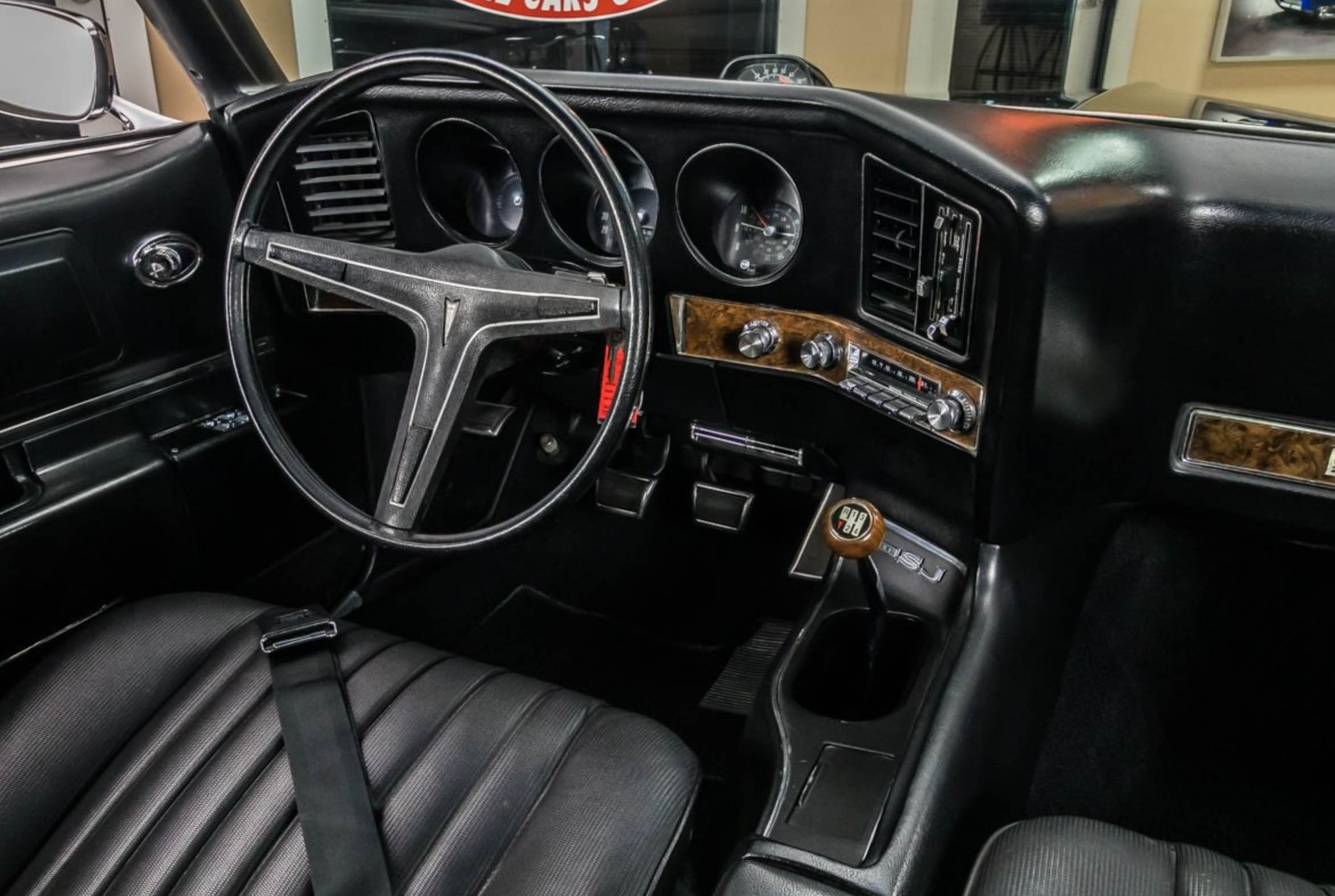
The interior featured enough room for a family as long as they didn’t mind crawling into the back seat through the massive front door openings; as kids we were so small and skinny we could slither back there without folding the front seats forward.
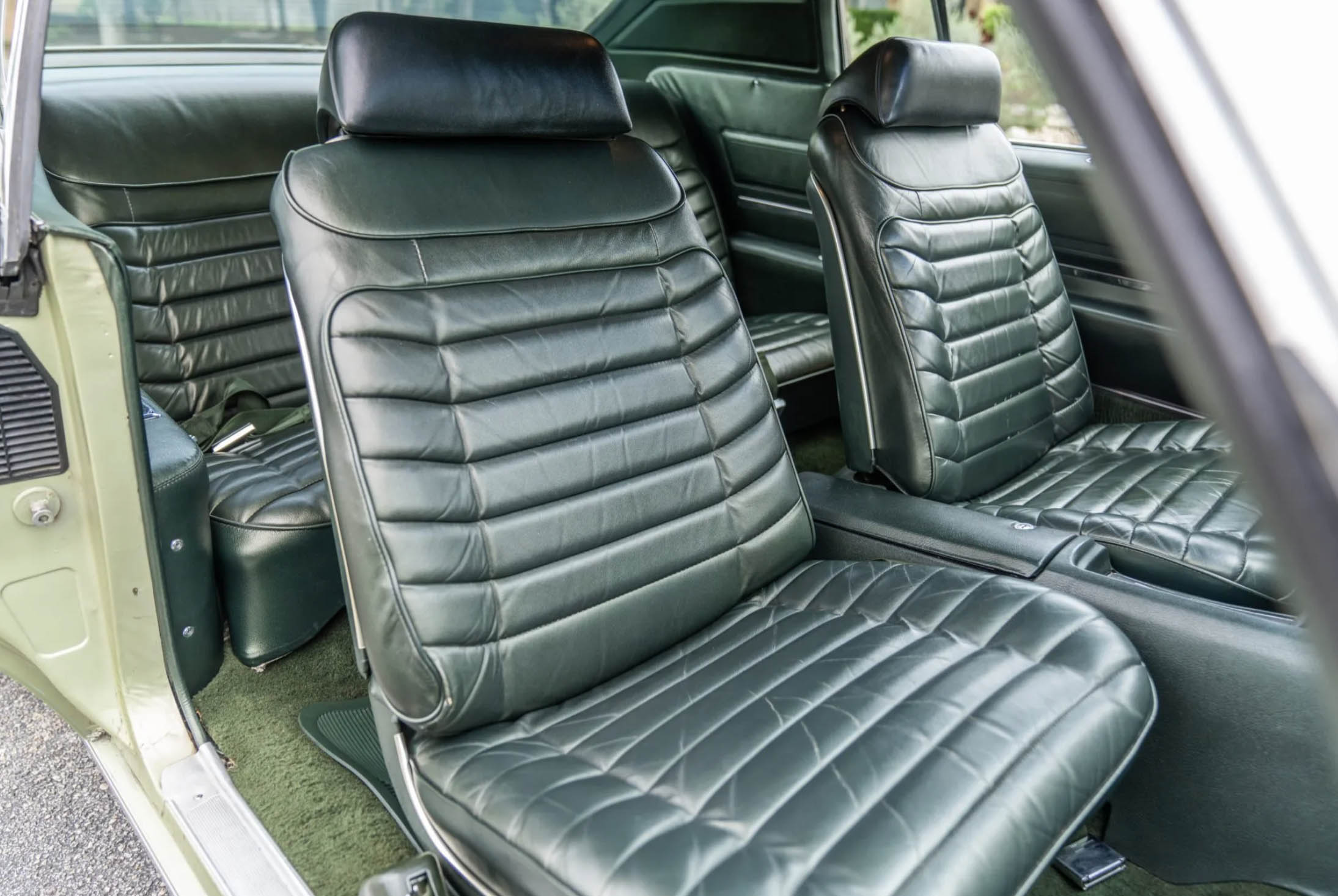

What’s an American car of the late sixties or early seventies without a giant trunk comically filled with spare tire?
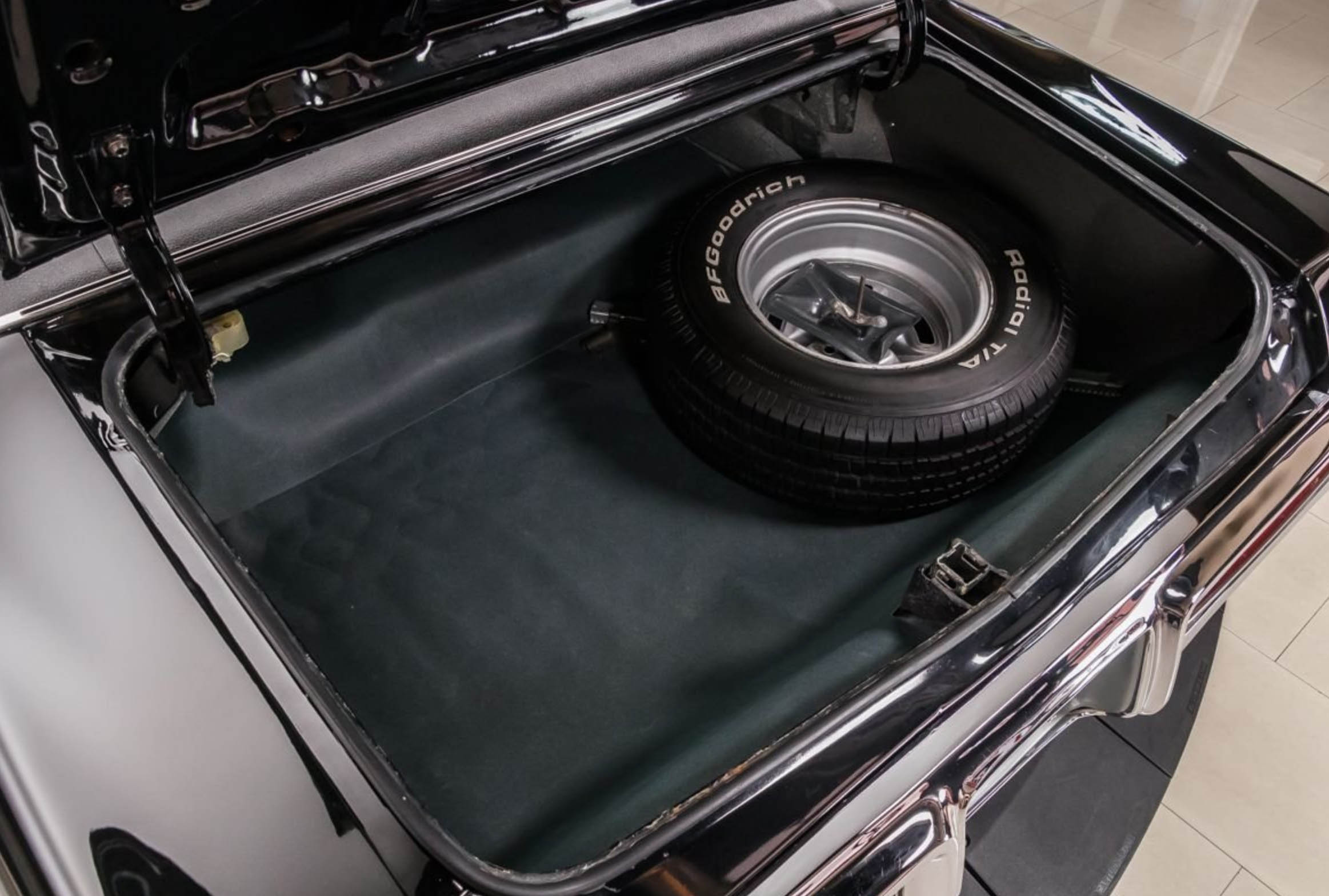
Forget some dull straight six; you only have V8 options with the ’69 GP. The standard 400 cubic inch motor packed either 265 hp or 350 hp, while moving up to the 428 gave you 370 hp.
Ah, but the upgraded SJ package gave you more than just a few extra trim pieces. With that bigger V8 standard plus power front disc brakes and automatic leveling rear airbag/ shocks it gave a more roadable Grand Prix. However, the ultimate SJ packed the optional handling package and the 390-bhp H.O. engine with a 3.55:1 axle ratio.
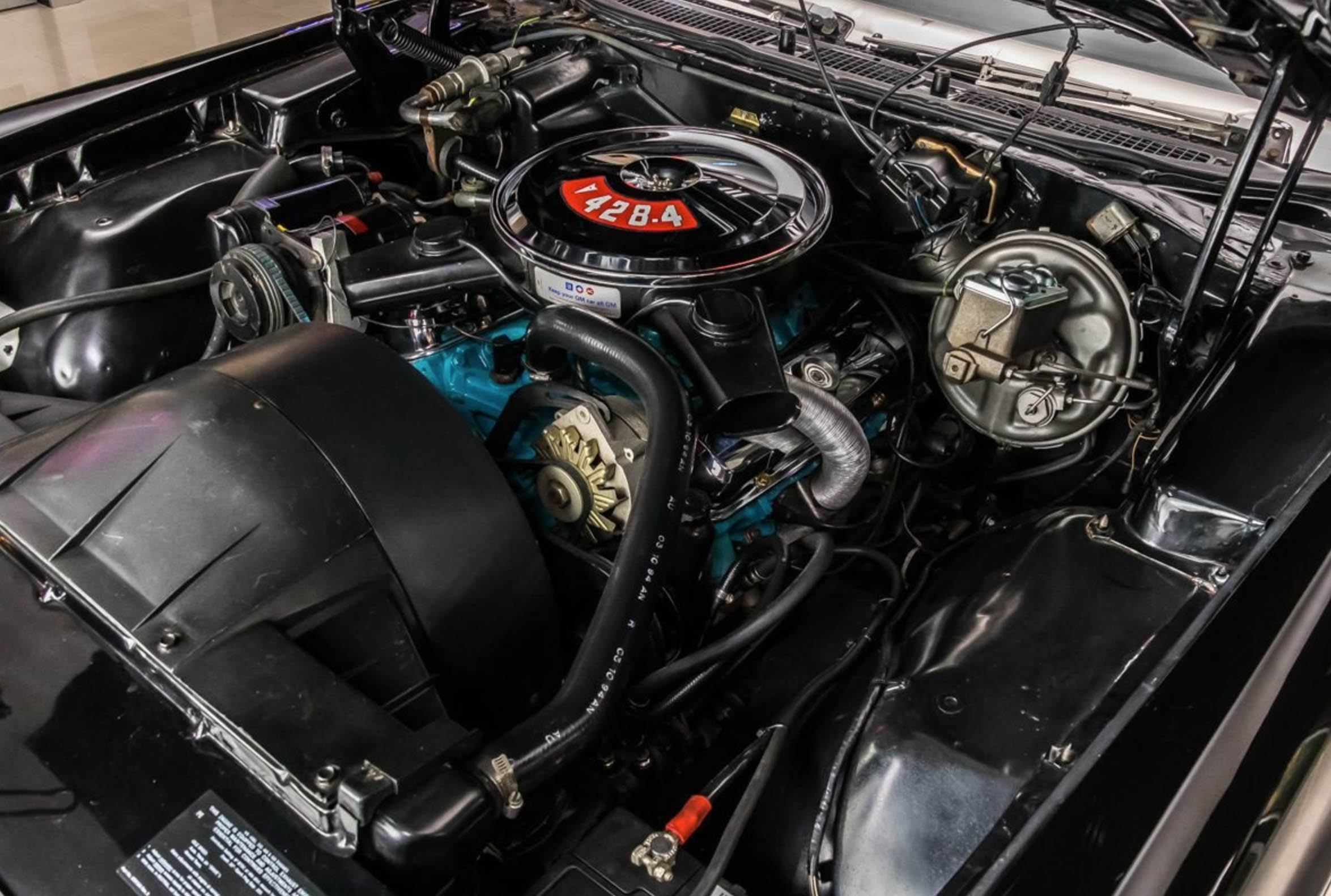
The SJ version was the one that Pontiac truly marketed as the grown-up Goat. You can see below that even in appearance the cars have vastly different personalities despite sharing mechanicals.
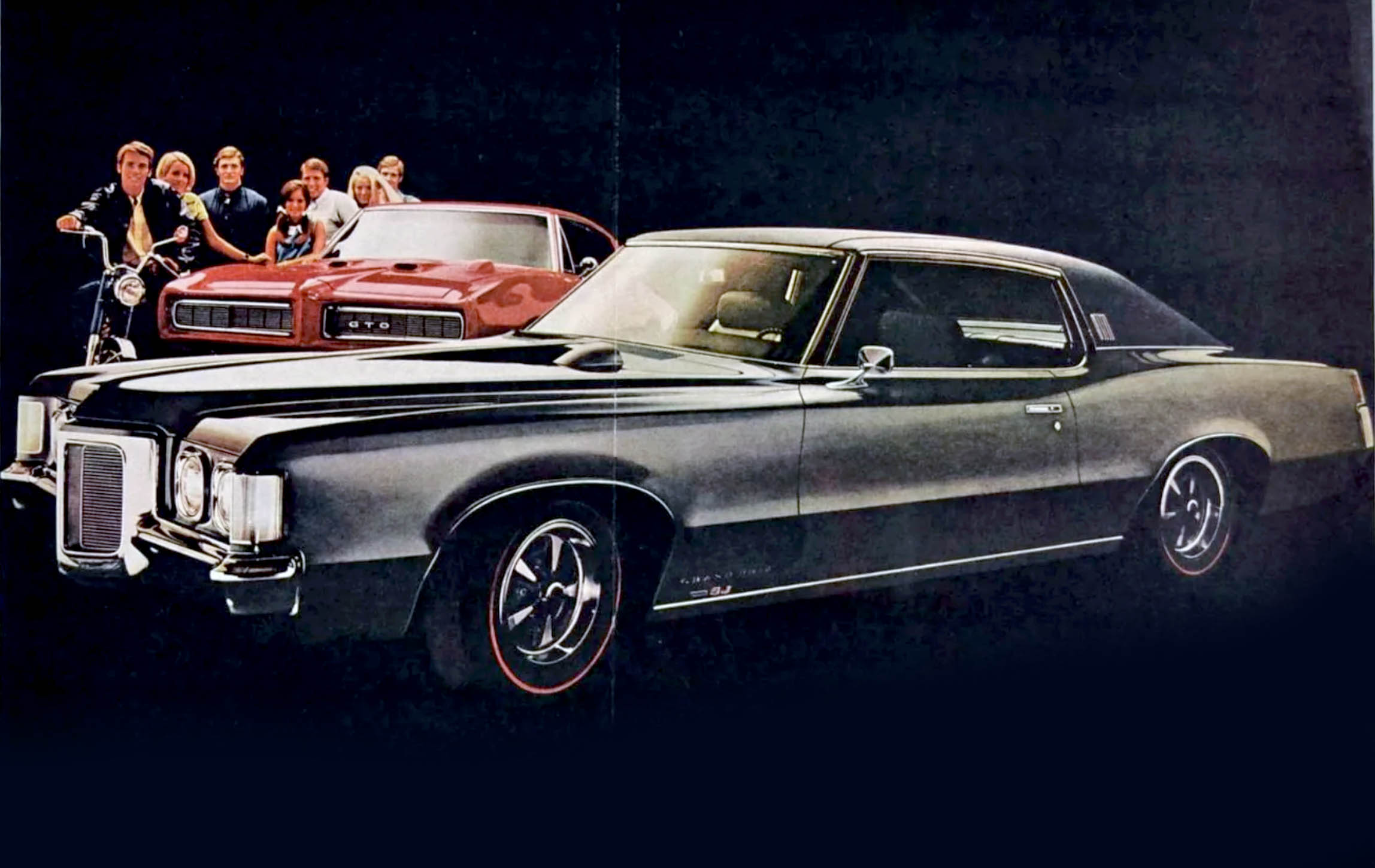
Still don’t believe in John Delorean’s commitment to the cause of keeping it sporty? How about a manual transmission-equipped personal luxury car? That’s right; a three-speed manual was standard for the cheapskates that wouldn’t pop for an automatic, but a four speed was available as an option in either a close- or wide-ratio gears. Yes, even with the HO V8. Word of note: Pontiac at the time claimed that engines in automatic and manual transmission cars produced the same horsepower. However, a post in Curbside Classic claims that the camshaft in automatic cars had less duration, less overlap, and slightly less lift than the one in stick cars; if true, those four-speed HOs had more power. They were also rare as hen’s teeth. Reportedly only 713 Grand Prix buyers selected one with a four on the floor (or 676, depending on your source), and a mere 116 chose that gearbox with the 390 horsepower HO motor.
A 1969 Pontiac Grand Prix HO with the 4-speed manual transmission was tested by Motor Trend and achieved a quarter-mile time of 14.5 seconds at 94.9 mph and 0 to 60 time of 6.8 seconds. Not mind-bending numbers, but enough to blow away more expensive coupes of the day while still coddling occupants in luxury. Vinyl and fake wood luxury, to be sure, but luxury.

Jay Leno typically saves his breath for cars worth talking about, and there’s a lot to say and love about this original example of SJ 4-speed that he sampled some time ago. Look at that glorious brown paint!
It would be an understatement to say that this smaller Grand Prix connected with buyers; the 112,486 units sold for 1969 was four times the numbers of the previous year. However, only 1,105 cars had the 428 H.O. engine, a scant 11,083 had the SJ package at all. It might have been marketed as a GT, but four out of five buyers were fine with something that merely looked like a sporting car, paving the way for the downward spiral of the personal luxury car image.
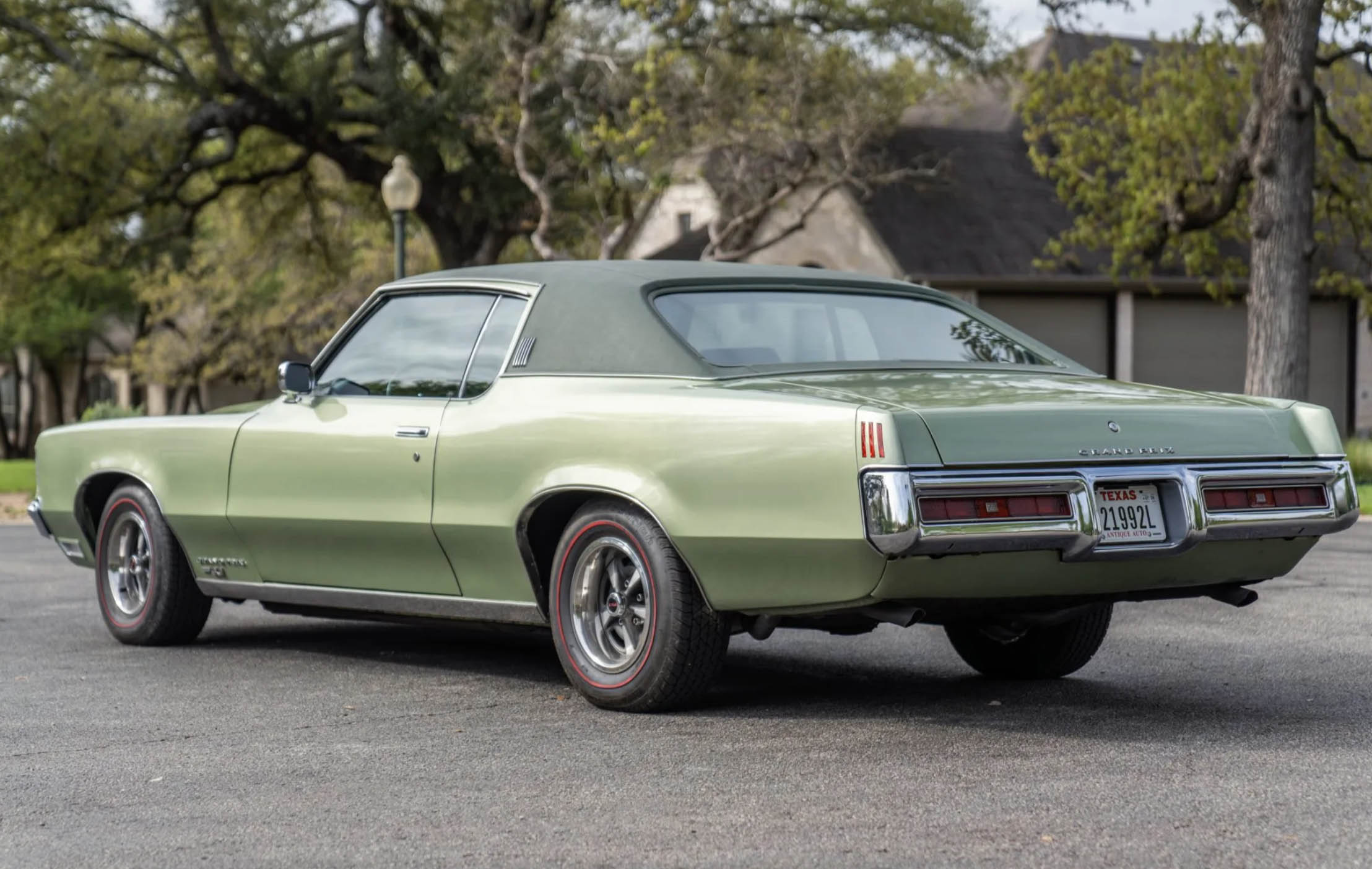
Today, that unjustified “fat coupe” image of later cars in general seems to taint the values of these overlooked Pontiacs. You don’t see a lot out there, but Bring A Trailer recently sold the great condition green automatic HO ’69 Grand Prix you see in the picture above for $34,100, a seemingly stonking deal on what has to be one of the better all-around Pontiacs ever. Those low values mean that you might as well get some use out of an example that you’d buy; certainly, it’s one of the most pleasant muscle cars to operate and ride in. As Jay Leno tells the owner of that brown one in the video above that claims to put only about 50 miles a year on his: “You really ought to drive this more.”
Maybe He Wanted A Pontiac With Gullwing Doors
Twelve months after the 1969 Grand Prix’s introduction, Chevrolet launched their version called the Monte Carlo that totally kicked off the personal luxury car boom. Sadly, other than the ultra-cool SS 454 model sold for the first two years in very limited numbers, the Monte Carlo featured more pasted-on luxury excess, totally forsaking the original “American gentlemen’s express” concept. Even worse, the cheaper 1970 Monte Carlo sold better, sapping nearly forty percent from the Grand Prix’s first year sales numbers. The writing was on the wall for the “banker’s hot rod” turning into “Aunt Sadie’s car to impress the girls at bingo”.
On February 15th, 1969, John DeLorean was promoted to lead the top-selling Chevrolet division; a move that would typically be the steppingstone to the King of General Motors throne. We know now that John had other ideas.
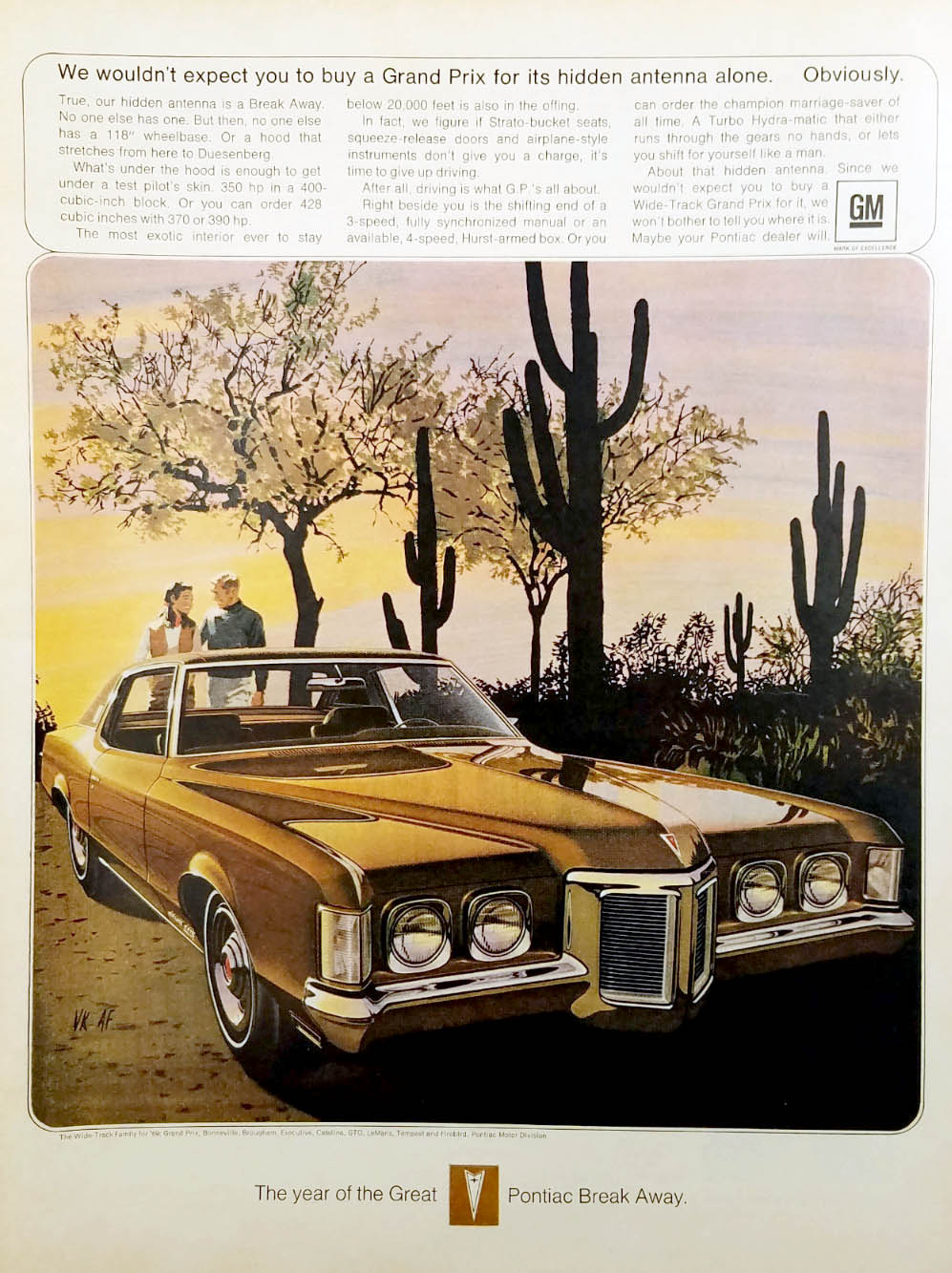
With DeLorean gone from Pontiac, his vision for a performance division waned quickly, and the trajectory to a button-tufted velour upholstered marshmallow of a car quickly distanced the Grand Prix from any hope of being the American BMW 3.0CS coupe that John might have had initially had in mind.
That shouldn’t affect your opinions on the first iterations of the first true personal luxury car; arguably the greatest Grand Prix of all time. It wasn’t perfect, but it did give us a glimpse of an appealing what-if personal luxury coupe genre that wouldn’t have been a malaise-era punchline.
Pontiac Points: 88/ 100
Verdict: If ever an American car perfectly balanced the muscle car experience with manageable size and tasteful luxury, this was it.
Top Image: Orlando Classic Cars









That black 67 tho…
PS, my mom always drove Pontiacs after their divorce and literally cried when GM dropped Pontiac. She did have a first gen Fiesta as her runabout, but Pontiacs were always special to her. My Mom remembers her parents early 50’s Pontiac and its lighted up hood ornament. These lighted badges on cars now is not a new trend. History proves, everything trendy will repeat itself
Damm, did that ever bring back memories Bishop! I was taken home after birth in the back seat of a 66 Grand Prix. My parents bought a brand new Grand Prix every year up until 86. Always loaded with every option. Dad hated the 78’s downsizing, but Mom loved it. She could park it without bumping into stuff. Dad was so mad at the discontenting of the last Grand Prix and issues(85 model), they bought a new loaded Camry LE and never looked back. Every GP they ordered was optioned to the gilt! I grew up with many astroroofs. On the good GP’s they didn’t leak at the car wash. Thanks for the memory Bishop. Oh every damm GP they ordered was in whatever dark shade of red they offered that year (Dad’s favorite car color). My personal fave was their 82 tu tone model with the super soft velour seats.That was my car briefly. Damm college parties and ditches after 5 too many, oh well
Yes, my mom’s twin sister got a new ’79 (the only non-Ford they ever had) and it was her favorite car. The later G-bodies drive a lot better than you’d think.
I remember my aunt’s 1980 GP had two lines down the windshield that was the “hidden antenna” and it didn’t pick up stations worth a damn.
those windshield antennas didn’t pick up poo if you were within 50 miles of a radio station, let alone 50 miles away LOL they truly were awful. And just dare turn on the windshield wipers during rain and try to get reception! They were truly awful. There is a reason vacuum windshield wipers and antennas met the trash bin. They both were truly awful
Yeah, I always wondered why windshield antennas were always standard but GM cars offered an optional power antenna. Drive one with the former and you’ll fully understand.
I feel like the Grill on these was polarizing enough to be fully love it or hate it and very little indifference in the middle. An Olds 88, with two doors was certainly less polarizing. the similar but better executed Riviera was probably less polarizing even, But the higher end performance Skylark’s and Cutlass’s were blurring the lines between high end but still not a full size land yacht and were far more popularly styled by 69
My first stepfather had one of this generation Grand Prix when he married my mother. An SJ, but with the smaller V8 and an automatic. Red on black. In ’76 he special ordered a ’77 new one, the next generation. White on lipstick read leather, fully loaded, but by then the big motor options were gone so IIRC it had the same motor, but more smog-strangled (he complained it was much slower than the old one). Also automatic. That was when he retired from the Air Force, and became a postman, later postmaster. And had a long commute every day. Eventually racked up over 300K on the thing. Loved his Pontiacs, though sadly the mighty Grand Prix was replaced by a GoooLE in the late ’80s just before they divorced (hell of a step down, that). I think he bought one of the last G6’s and drove it until he croaked a decade or so ago.
And while pregnant with my brother, the ’77 being just a few months old, my newly-licensed mother managed to hit the gas instead of the brake and put the car through the back of the garage into a tree in the back yard. Being brand-new, it wasn’t totaled, but it was close. Explains a lot about my brother…
Absolutely loving this weekly Pontiac content!
1000% agreed!
My first car was a 77 Grand Prix, rally wheels, silver with red top. Bought from a family friend after I went into the Navy in 85 for $1k. I drove the crap out of that thing, all around the eastern US down to FL and up to NY. Narry a problem.
Of course I did silly things to it like any teen/early 20s new driver. But damn it was fun for what it was.
back in the 70s my mom had one of these with the long hood, beak and it was maroon/red? with white leather interior. Even though I was under 10 years old, I thought the idea of a 2 door with white leather for a single mom with 4 kids and a few dogs was not a great idea. She loved it though.
Imagine being a kid in a family with four today. Stuck in a car seat in the third row of a minivan. Consider yourself blessed.
Nah, the car seats are in the middle row. The older kids get stuffed in the way-back, since they can get their on their own.
But yeah, strapped into car seats like a prisoner (and largely unable to see anything in most of them) until nearly school age, then having to use a booster seat until *Jr High* for the pipsqueak kids AND forbidden from the front seat too lest the airbag take your head off. It wasn’t “safe”, but I sure loved rattling around in the back of my grandparent’s plywood pleasure palaces as a kid, and sitting up front and shifting for my Mom or Grandmother. And the beds of pickups was fun when the weather was nice.
Kids may be safer today, but I sure feel like a lot of the fun of childhood is lost today. Children just aren’t allowed to be feral anymore.
I’m really liking that 1962 Grand Prix up there.
I’m not sure how JZDL got Engineering to sign off on the extra 2 inches of wheelbase since Monte Carlos were 116″, as were all 4-door A bodies. They basically put the coupe body intended for a 112″ wb on the sedan chassis and reallocated the stretch to hood length.
That being said, they did move the engine back in the chassis which made for better weight distribution.
Good call out. I always wondered about the additional 2″ wheelbase compared to the MC. Thought corporate would dictate all ‘A-specials’ to be the same.
That said I prefer the MC styling over the GP
They also added about 6″ in front of the front wheels. The result is the world’s longest fan shroud and fenders that are 6′ long! I own a 1971 MC and can attest to everything you said. It actually led to an interesting problem. I swapped a Muncie 4 speed into my car many years ago and the Z-bar clutch system needs a bracket attached to the frame. Since the engine is further back in the frame, the similar bracket for a Chevelle doesn’t work. No-one was reproducing these brackets at the time (1995) so I ended up fabricating my own.
In 1969 I was driving in the hills of western Pennsylvania about 3AM. 90 MPH, slow to 60 for the towns. One of these things just BLEW past me. It even went “whoosh” as it went by.
I suspect neither of the 69 Grand Prix in my life had 4 on the floor or an HO engine. The divorcee who lived next door in 1970 had a bright blue Grand Prix with a white vinyl roof, and the only thing that fascinated me was the door handles. Then again we had a Mercedes W108 and a Plymouth Valiant, so the adults were moving in different directions.
My future father in law also had a Grand Prix and a Beetle, with Automatic Stickshift, I don’t think my mother in law ever learned to drive with a manual transmission. He was an electrical engineer so his GP was probably a base engine and auto.
This is the 2nd post I’ve seen recently that referred to the GP and MC as a G-body. In the period, they were referred to as “A-special”, and there was no such thing as a G-body until the 1983? MY, when the A-bodies went FWD and the remaining RWD intermediates switched to G-body.
I never heard these called G-bodies until recently. It’s weird.
The 6th gen that came out in the late 80s might be a fair candidate for the banker’s hot rod title. I know at least for the first few years, they could be had with manuals, and there was a hotted-up turbo version as well.
For the style of the time, they did a good job.
One of my absolute favorites. It’s the Duesenberg trim names that do it for me. An SJ is a dream car for me
One of my college roommates drove a beautiful dark blue ‘70 Grand Prix with a white vinyl top. I think it was an SJ, but not certain. That car was the best road trip car I’d ever ridden in to that point and that big V-8 just ate highway in a blink (gas, too). And oh my heavens did that Grand Prix pull women. This generation Grand Prix is one of my top five favorite Pontiacs.
As an aside, my next door.neighbor who owned the garage where I worked through high school, bought his young wife a ‘70 Monte Carlo SS. She used to give me rides in it without ever switching on the ignition.
My biggest takeaway from this is that the 67-68 model has almost as much sinister presence as a 68-70 Dodge Charger, which is especially impressive given that it has fender skirts.
Also, where is all this personal-luxury car hate coming from??? Personal luxury cars are awesome, and absolutely saved the malaise era from being completely dreary and devoid of interesting vehicles. Yes, personal luxury cars may have been overdone in the 70s due to American automakers not really being able to make anything interesting otherwise, and 70s luxury cars faced the same kitschy decor that was everywhere in the 70s, but they were still great for their intended purpose – they were stylish (at the time, at least), fun to look at, extremely comfortable, and generally pretty affordable. Plus, you can easily make them a lot faster and cooler-looking today with different wheels and minor engine tweaks or LS-swaps 😉
They had the same coolness of a muscle/pony car, but with a focus on comfort over performance, and sometimes you could in fact get performance as well (albeit typically geared for passing people on the highway rather than optimizing the 0-60 time).
It’s also pretty impressive IMO when a full-size car can out-accelerate a compact or midsize muscle/pony car, and especially fun when those big powerful engines can be had for a lot less money in full-size classics nowadays than in traditional muscle cars. Full-size American Muscle deserves a lot more love than it gets. Also, does the size of the car really matter that much anymore when restomods frequently pump out over 1,000 hp and disc brake conversions are commonplace? At that point, a RWD car is a RWD car.
With most PLCs it’s how you trim it out and equip it under the hood. The various Monte Carlo SS models also prove that out.
My brother was a designer at GM, in the Pontiac studio when DeLorean was the chief, but only for maybe a year before DeLorean’s move to Chevy. I don’t remember if my brother became the studio chief, or if he got promoted to studio chief level some time later.
Fun story from that period was when he drove his ’69 black Pontiac Gran Prix SJ 428 HO (company car) to his high school reunion. I was home from college that weekend, so we went cruising at the usual car guy spots. When we got bored with that we headed back home. At the last traffic light before our neighborhood an orange ’69 Pontiac GTO Judge pulled up next to us and began reving his engine like crazy, My brother never even turned his head to look at the challenger, but he said to me “watch this”.
When the light turned green the Judge’s tires immediately released a cloud of rubber smoke. But within less than half a car length we rocketed past it in that Gran Prix, without even spinning it’s tires! “Judge that!” my brother cracked. We laughed our asses off. Great memory. The Gran Prix wasn’t in the class of cars that appealed to me, but it was tremendous fun humiliating the GTO driver. I’ve chuckled to myself whenever I’ve seen a Judge ever since.
Colin, that’s a great story! Thank you so much for sharing.
That’s EXACTLY what I was talking about. You would never want to drive up to a business meeting or country club in an orange-with-pink-stripes GTO but a black Grand Prix would likely have gotten you as much respect as a far more expensive Caddy or Lincoln.
These are awesome and seriously under appreciated, thanks for shedding a light on them here.
Oldsmobile had the Hurst/Olds with 455/390HP and the Toronado GT with 455/400HP.
Supercharged Studebaker Hawks and Buick Riviera Gran Sports seem to fit the PLC / Grand Tourer mold too.
Yes, they do, but they weren’t really affordable. You needed to be Mr. Spock to afford a Riv, and my dad could only afford the used Hawk four-speed he bought back in the day.
Your dad made an excellent choice.
The styling seems way ahead of its time. If you asked me to guess when the late 60s versions were made, I would have said late 70s.
GM’s styling in the 1960s was a high point in automotive history.
Once 1970 and the Monte Carlo came out, it looks so much better.
“Many consider this Grand Prix to be the very first true “personal luxury” car…”
Ford Thunderbird enters the chat.
I probably should have quantified that by calling it the first of what became the standard for PLCs. The T-Bird up to that point was a rather upscale and quite expensive car sharing more with Lincolns of the time.
The Grand Prix shared mechanicals with run-of-the-mill mid sized cars (to the point that in later years you could put a Monte Carlo clip onto an El Camino).
Ultimately the T-Bird followed GM’s lead and shared with the Torino/LTD II for the ’77 model with the expected reduction in price and sold through the roof.
True – Grand Prix really was a more attainable and driver’s-oriented PLC than Thunderbird ever was until the Turbo Coupes came along in the early 80s.
So do the Chrysler 300 Letter cars.
Those could absolutely be put in the category (I mention them in my post) but as I said those were very expensive cars. In fact, even the 1962 GP was designed to be a lower cost version of that kind of car. The ’69 was meant to be even more accessible (in terms of cost and size) and that’s what the industry latched onto.
I have the last PLC- an XV30 Solara, which outlasted the Monte Carlo by one model year. I’m not sure the Accord coupe qualifies, but maybe?